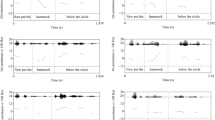Abstract
Speakers are often disfluent, for example, saying “theee uh candle” instead of “the candle.” Production data show that disfluencies occur more often during references to things that are discourse-new, rather than given. An eyetracking experiment shows that this correlation between disfluency and discourse status affects speech comprehension. Subjects viewed scenes containing four objects, including two cohort competitors (e.g., camel, candle), and followed spoken instructions to move the objects. The first instruction established one cohort as discourse-given; the other was discourse-new. The second instruction was either fluent or disfluent, and referred to either the given or new cohort. Fluent instructions led to more initial fixations on the given cohort object (replicating Dahan et al., 2002). By contrast, disfluent instructions resulted in more fixations on the new cohort. This shows that discourse-new information can be accessible under some circumstances. More generally, it suggests that disfluency affects core language comprehension processes.
Similar content being viewed by others
REFERENCES
Allopenna, P. D., Magnuson, J. S., & Tanenhaus, M. K. (1998). Tracking the time course of spoken word recognition using eye movements: Evidence for continuous mapping models. Journal of Memory and Language, 38, 419-439.
Almor, A. (1999). Noun-phrase anaphora and focus: The informational load hypothesis. Psychological Review, 106(4), 748-765.
Ariel, M. (1990). Accessing Noun-Phrase Antecedents. London: Routledge.
Arnold, J. (1998). Reference Form and Discourse Patterns. Ph.D. Dissertation, Stanford University.
Arnold, J. E. (2001). The effect of thematic roles on pronoun use and frequency of reference Continuation. Discourse Processes, 31(2), 137-162.
Arnold, J. E., Eisenband, J. G., Brown-Schmidt, S., & Trueswell, J. C. (2000a). The rapid use of gender information: Evidence of the time course of pronoun resolution from eyetracking. Cognition, 76, B13-B26.
Arnold, J., Wasow, T., Ginstrom, R., & Losongco, T. (2000b). Heaviness vs. newness: The effects of structural complexity and discourse status on constituent ordering. Language, 76(1), 28-55.
Bailey, K. G. D., & Ferreira, F. (2002). Disfluencies affect the parsing of garden-path sentences. Manuscript, Michigan State University.
Barr, D. J. (2001a). Trouble in mind: Paralinguistic indices of effort and uncertainty in communication, In C. Cavé, I. Guaïtella, & S. Santi (Eds.), Oralité et gestualité: Interactions et comportements multimodaux dans la communication (pp. 597-600). Paris: L'Harmattan.
Barr, D. J. (2001b). Paralinguistic correlates of discourse structure. Poster presented at the 42nd Annual Meeting of the Psychonomic Society, Orlando, FL, Nov. 15-18.
Brennan, S. E. (1995). Centering attention in discourse. Language and Cognitive Processes, 10(2), 137-167.
Brennan, S. E., & Schober, M. E. (2001). How listeners compensate for disfluencies in spontaneous speech. Journal of Memory and Language, 44(2), 274-296.
Clark, H. H., & Sengul, C. J. (1979). In search of referents for nouns and pronouns. Memory and Cognition, 7, 35-41.
Clark, H. H., & Wasow, T. (1998). Repeating words in spontaneous speech. Cognitive Psychology, 37, 201-242.
Dahan, D., Magnuson, J. S., & Tanenhaus, M. K. (2001). Time course of frequency effects in spoken word recognition: Evidence from eye movements. Cognitive Psychology, 42, 317-367.
Dahan, D., Tanenhaus, M. K., & Chambers, C. G. (2002). Accent and reference resolution in spoken language comprehension. Journal of Memory and Language, 47, 292-314.
Fisher, B. (1992). Saccadic reaction time: Implications for reading, dyslexia and visual cognition. In K. Rayner (Ed.), Eye movements and Visual Cognition: Scene Perception and Reading (pp. 31-45). New York: Springer-Verlag.
Fox Tree, J. E. (1995). The effects of false starts and repetitions on the processing of subsequent words in spontaneous speech. Journal of Memory and Language, 34, 709-738.
Fox Tree, J. E. (2001). Listeners' uses of um and uh in speech comprehension. Memory and Cognition, 29(2), 320-326.
Fox Tree, J. E., & Clark, H. H. (1997). Pronouncing "the" as "thee" to signal problems in speaking. Cognition, 62, 151-167.
Givón, T. (1983). Topic Continuity in Discourse: A Quantitative Cross-Language Study. Amsterdam: John Benjamins Publishing.
Hudson-D'Zmura, S., & Tanenhaus, M. K. (1998). Assigning antecedents to ambiguous pronouns: The role of the center of attention as the default assignment. In M. Walker, A. Joshi, & E. Prince (Eds.), Centering Theory in Discourse (pp. 199-226). Oxford: Oxford University Press.
Gordon, P. C., & Chan, D. (1995). Pronouns, passives, and discourse coherence. Journal of Memory and Language, 34(2), 216-231.
Gordon, P. C., Grosz, B. J., & Gilliom, L. A. (1993). Pronouns, names, and the centering of attention in discourse. Cognitive Science, 17, 311-347.
Gordon, P. C., & Scearce, K. A. (1995). Pronominalization and discourse coherence, discourse structure and pronoun interpretation. Memory and Cognition, 23(3), 313-323.
Gundel, J. K., Hedberg, N., & Zacharaski, R. (1993). Cognitive status and the form of referring expressions. Language, 69(2), 274-307.
Marslen-Wilson, W. (1987). Functional parallelism in spoken word recognition. Cognition, 25, 71-102.
Rossion, B., & Pourtois, G. (2001). Revisiting Snodgrass and Vanderwart's object database: Color and texture improve object recognition. Paper presented at the 1st Vision Science Conference, Sarasota, Florida, May, 2001.
Snodgrass, J. G., & Vanderwart, M. (1980). A standardized set of 260 pictures: Norms for name agreement, image agreement, familiarity, and visual complexity. Journal of Experimental Psychology: Human Learning & Memory, 6(2), 174-215.
Tanenhaus, M. K., Spivey-Knowlton, M. J., Eberhard, K. M., & Sedivy, J. C. (1995). Integration of visual and linguistic information in spoken language comprehension. Science, 268(5217), 1632-1634.
Tanenhaus, M. K., Spivey-Knowlton, M. J., Eberhard, K. M., & Sedivy, J. C. (1996). Using eye movements to study spoken language comprehension: Evidence for visually mediated incremental interpretation. In T. Inui & J. L. Mlelland (Eds.), Attention and Performance XVI: Information Integration in Perception and Communication (pp. 457-478). Cambridge, MA: MIT Publishing.
Author information
Authors and Affiliations
Rights and permissions
About this article
Cite this article
Arnold, J.E., Fagnano, M. & Tanenhaus, M.K. Disfluencies Signal Theee, Um, New Information. J Psycholinguist Res 32, 25–36 (2003). https://doi.org/10.1023/A:1021980931292
Issue Date:
DOI: https://doi.org/10.1023/A:1021980931292




